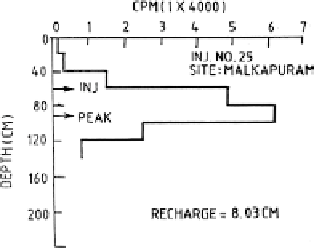Geoscience Reference
In-Depth Information
Fig. 2.
Recharge profile at Malkapuram.
46 sites were selected in Kunderu basin and tritium was injected in the
month of July before the commencement of monsoon rains. The depth
of injection was 80 cm. The sites were distributed uniformly in various soil
types covering different geological formations. The location of tritium injec-
tion sites in Kunderu basin is shown in Fig. 1. Tritiated water (2.5 ml) hav-
ing an activity of 10
µ
C/ml was injected at selected depth in a hole made by
using drive rod. Vertical soil core profiles were collected from the injected
sites with a 20 cm sampling interval after the monsoon cessation. The max-
imum depth of collection was 250 cm. Moisture content of the samples was
determined with torsion balance. The soil samples were subjected to par-
tial vacuum distillation for extracting soil moisture. 4 ml of the distillate
was mixed with 10 ml of Instagel (Scintillator cocktail) in low potash glass
vials (capacity 20 ml) and the tritium activity of the sample was counted by
Scintillation spectrometer. The recharge in the case of each site was calcu-
lated by determining the peak/center of gravity of the tritium versus depth
profiles. The mean displacement of the tracer is calculated from the depth
of injection to the peak/center of gravity. The net recharge was taken as the
length of an imaginary water column over a square centimeter in the soil
profile interval between the depth of injection and the depth of peak/center
of gravity. Recharge was computed using tracer displacement and moisture
content data. Figure 2 shows typical tritium profile of Kunderu river basin
at Malkapuram.
4. Results and Discussions
The recharge values were found to vary from 26 to 94 mm. The arithmetic
mean of all the recharge values is 29 mm with a standard deviation of 24 mm.









